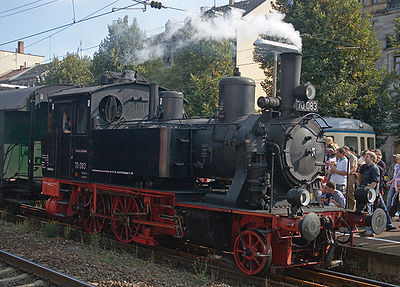- Bavarian Pt 2/3
-
Bavarian Pt 2/3
DRG Class 70.0
ÖBB 770Number(s): DRG 70 001–097 Quantity: 97 Manufacturer: Krauss Year(s) of manufacture: 1909–1915 Retired: 1963 Wheel arrangement (Whyte): 2-4-0 Axle Arrangement (UIC): 1B h2 1'B h2 Gauge: 1,435 mm Length over buffers: 9,065 mm 9,165 mm 9,265 mm Service weight: 38.4 t 39.5 t 39.9 t Adhesive weight: 27.2 t 28.3 t 28.4 t Axle load: 13.6 t 14.1 t 14.2 t Top speed: 65 km/h Indicated Power: 310 kW Driving wheel diameter: 1,250 mm Leading wheel diameter: 850 mm 1,006 mm No. of cylinders: 2 Cylinder bore: 375 mm Piston stroke: 500 mm Boiler overpressure: 12 bar Grate area: 1.22 m² Superheater area: 18.40 m² Evaporative heating area: 58,10 m² Locomotive brakes: Westinghouse compressed air brake on front of 1st coupled axle and rear of 2nd coupled axle; counterweight brake in driver's cab The two-cylinder, superheated Bavarian Pt 2/3 engine was built by Krauss for the Royal Bavarian State Railways (Königlich Bayerische Staats-Eisenbahnen) between 1909 and 1915. With its characteristic design - a carrying axle placed well to the front and two coupled axles at the rear under the outer firebox they asserted themselves over the rival Bavarian Pt 2/4 N and H classes and, after the demand fell for the services for which they were originally designed, they continued to be operated well into the 1960s on south German branch lines.
A total of 97 examples were built in three variants that only differed slightly from one another. Up to 1937, 50 engines were equipped with a Bissel axle; (the axle arrangement changed as a result from 1B to 1'B). The constructional feature of this locomotive was the unusually large distance between driving and carrying axle of 4,000 mm or, on the final six units, of 4,050 mm. This resulted in a lighter, but economically more sensible, lightweight design, that proved to be outstanding.
Behind the idea of the Pt 2/3 stood the concept of "light trains", whereby the guard was saved at the expense of the fireman, who accessed the train through a door in the back wall of the locomotive, whereupon he had to take over all the duties of the guard. The Pt 2/3, later DRG Class 70, was ousted from its original duties by electrification and by stronger locomotives like the Class 64 and moved into branch line services, where it remained for many years as a result of its economy. The doors on the rear wall, which had become superfluous, were in some cases removed in order to provide a larger coal bunker.
The Deutsche Bundesbahn took over 89 locomotives; four remained in Austria, three apparently as a result of military action were no longer worth repairing and one had been mustered out in 1935. The last engine, no. 70 083, was retired by the Nuremberg federal railway division in 1963 and transferred to Munich. After spending almost forty years as a memorial in Mühldorf am Inn, the Bavarian Branch Line Union (Bayerische Lokalbahnverein) was able to placed the loco in service again in 2005.
After the Second World War, numbers 70 086, 092, 095 und 096 remained in Austria, and were preserved as ÖBB Class 770. Their main area of operation was the Pöchlarn–Kienberg-Gaming line. No. 770.086 was paid off on 31 January 1967 as the last of its type. This locomotive, which was then displayed at Pöchlarn station was reactivated in 1997 and, since 1999, has headed specials for the Brenner & Brenner Steam Locomotive Company (Brenner & Brenner Dampflokomotiven Betriebsgesellschaft).
Literature
- Andreas Knipping: Die Baureihe 70 - Die bayerische Tenderlok für leichte Züge und ihre badische Schwester. EK-Verlag, Freiburg (1998) ISBN 3-88255-170-9
See also
External links
- There is a relevant English-language forum at Railways of Germany
Classes of Bavarian locomotive Early locomotives 
Passenger and express train locomotives Goods train locomotives Tank locomotives Branch line locomotives D VI · D VII · D VIII · D X · D XI · BB II · PtL 2/2 (Maffei) · PtL 2/2 (Krauss) · PtL 3/3 · PtL 3/4 · PtzL 3/4 · GtL 4/4 · (GtL 4/5 - DRG 98.10) · (GtL 4/5 - DRG 98.11)Narrow gauge locomotives Electric locomotives Railbuses Bavarian Ostbahn locomotives A 1 - A 12 · A 13 - A 24 · A 1 - A 2 · B 1 - B 66 · B 67 - B 78 · B 79 - B 90 · B 91 - B 96 · B 97 - B 109 · C 1 - C 12 · C 13 - C 64 · D 1 - D 12 · C 13 - C 14Categories:- 2-4-0 locomotives
- Locomotives of Bavaria
Wikimedia Foundation. 2010.

